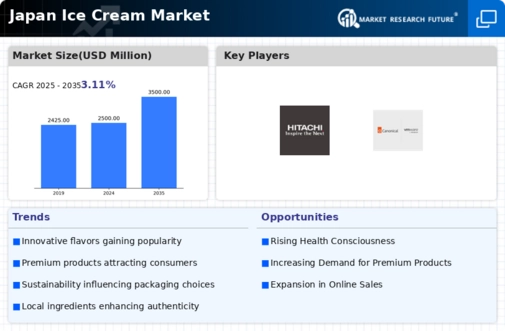Increased Focus on Local Sourcing
The ice cream market is increasingly emphasizing local sourcing of ingredients, which resonates with Japanese consumers' preference for fresh and high-quality products. This trend is driven by a desire to support local farmers and reduce the carbon footprint associated with transportation. Many ice cream brands are now highlighting their use of locally sourced fruits, dairy, and other ingredients, which enhances the authenticity and appeal of their products. In 2025, it is estimated that ice cream products made with local ingredients will account for around 25% of the market, reflecting a growing consumer inclination towards supporting local economies. This focus on local sourcing not only strengthens community ties but also enriches the flavor profiles of ice cream offerings, thereby driving growth in the ice cream market.
Innovative Flavors and Ingredients
The ice cream market in Japan is experiencing a surge in demand for innovative flavors and unique ingredients. Consumers are increasingly seeking out artisanal and gourmet options that offer a distinct taste experience. This trend is reflected in the growing popularity of flavors such as matcha, sake, and seasonal fruit varieties. In 2025, the market for premium ice cream products is projected to account for approximately 30% of total sales, indicating a shift towards more sophisticated offerings. The introduction of exotic ingredients not only enhances the flavor profile but also appeals to consumers' desire for novelty and adventure in their food choices. As a result, manufacturers are investing in research and development to create new and exciting products that cater to this evolving consumer preference, thereby driving growth in the ice cream market.
Seasonal and Limited-Edition Offerings
Seasonal and limited-edition ice cream products are becoming increasingly popular in Japan, contributing to the dynamic landscape of the ice cream market. Brands are launching special flavors that coincide with local festivals, holidays, and seasonal ingredients, which creates a sense of urgency and exclusivity among consumers. For instance, sakura-flavored ice cream is a seasonal favorite during cherry blossom season, while winter months see the introduction of rich, comforting flavors. This strategy not only boosts sales during specific periods but also enhances brand loyalty as consumers eagerly anticipate new offerings. In 2025, it is estimated that seasonal products will represent around 15% of total ice cream sales, highlighting the effectiveness of this marketing approach in attracting consumers and driving revenue in the ice cream market.
Sustainability and Eco-Friendly Practices
Sustainability is becoming a crucial driver in the ice cream market, as consumers in Japan increasingly prioritize eco-friendly practices. Brands are responding by adopting sustainable sourcing of ingredients, reducing packaging waste, and implementing energy-efficient production methods. This shift is not merely a trend but appears to be a fundamental change in consumer expectations. Research indicates that approximately 40% of Japanese consumers are willing to pay a premium for products that are environmentally friendly. Consequently, companies that embrace sustainability are likely to enhance their brand image and attract a loyal customer base. The integration of eco-conscious practices into the ice cream market is expected to continue growing, as consumers demand transparency and responsibility from the brands they support.
Rising Demand for Plant-Based Alternatives
The ice cream market in Japan is witnessing a notable increase in the demand for plant-based alternatives. As more consumers adopt vegan or lactose-free diets, the availability of dairy-free ice cream options is expanding. This shift is driven by health considerations, ethical concerns regarding animal welfare, and environmental awareness. In 2025, plant-based ice cream is projected to capture approximately 20% of the total market share, reflecting a significant change in consumer preferences. Brands are innovating by using ingredients such as almond milk, coconut milk, and cashew cream to create creamy, delicious alternatives that appeal to a broader audience. This trend not only diversifies the product offerings but also positions the ice cream market to cater to a growing segment of health-conscious consumers.

















Leave a Comment